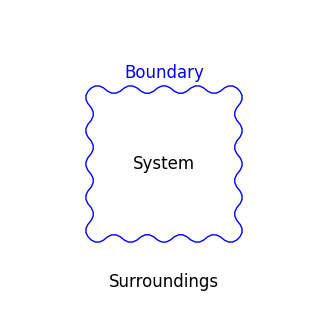2.1. Introduction to Statistical Mechanics#
Overview#
---
config:
layout: elk
look: handDrawn
theme: neutral
---
flowchart LR
%% Beginnings and ending
CM([Classical mechanics])
QM([Quantum mechanics])
Th([Thermodynamics])
%% Processes
KT[[Kinetic theory]]
SM[[Statistical mechanics]]
%% Inputs/Outputs
StateCM[/"<i>r<sup>N</sup></i>, <i>p<sup>N</sup></i>"/]
StateQM[/"Ψ(<i>r<sup>N</sup></i>)"/]
%% Decision
LimitCM{"Classical limit?"}
subgraph Microscopic World
QM
CM
StateCM
StateQM
LimitCM
end
subgraph Bridges
KT
SM
end
subgraph Macroscopic World
Th
end
CM --> StateCM
StateCM --> KT --> Th
StateCM --> SM --> Th
QM --> LimitCM
LimitCM -- Yes --> CM
LimitCM -- No --> StateQM --> SM
Macroscopic Properties as Expected Values of Microscopic Properties#
A core principle of statistical mechanics is that macroscopic thermodynamic properties can be interpreted as statistical averages (or expected values) of microscopic properties.
Arithmetic Average vs. Expected Value#
In basic statistics, an arithmetic average \(\bar{X}\) of a set of numbers \(X = \{ X_1, X_2, \ldots, X_M \}\) is:
Example of an Arithmetic Average
The arithmetic average of \(X = \{ 1, 2, 2, 3, 3, 3, 4, 4, 4, 4 \}\) is
In statistical mechanics, we often deal with an expected value, which accounts for the probabilities \(p_i\) of different microscopic states or outcomes. The expected value of a random variable \(X\) is:
where \(p_i\) is the probability of the \(i\)-th value \(X_i\), and the sum runs over all possible microstates.
Example of an Expected Value
If \(X\) takes the values \(\{1, 2, 3, 4\}\) with probabilities \(p = \{0.1, 0.2, 0.3, 0.4\}\), then
Expected Value of the Number of Tails in 100 Fair Coin Flips
Let \(X_\text{heads} = 0\) and \(X_\text{tails} = 1\). For one flip,
Hence, in 100 flips,
Expected Value of the Number of Sixes in 300 Fair Die Rolls
Let \(X_\text{six} = 1\) and \(X_\text{not-six} = 0\). Then, for one roll,
For 300 rolls,
Statistical Variable |
Statistical Mechanical Definition |
|---|---|
\(M\) |
Number of microscopic states (microstates) |
\(i\) |
Index of a microstate |
\(X_i\) |
Value of a microscopic property in the \(i\)-th microstate |
\(\langle X \rangle\) |
Expected (ensemble) average of \(X\) |
\(p_i\) |
Probability of finding the system in the \(i\)-th microstate |
In thermodynamics, typical \(X\) values might be the internal energy, enthalpy, or other measurable properties. We will see how to compute such properties by defining appropriate probabilities \(p_i\) for the relevant ensemble.
Ensembles of Microstates#
- Ensemble#
The set of all possible microstates of a system consistent with the macroscopic properties of the system.
- Microcanonical ensemble#
All microstates have the same number of particles, volume, and energy \(\left( N, V, E \right)\).
- Canonical ensemble#
All microstates have the same number of particles, volume, and temperature \(\left( N, V, T \right)\).
- Grand canonical ensemble#
All microstates have the same chemical potential, volume, and temperature \(\left( \mu, V, T \right)\).
Probability of a Microstate in the Microcanonical Ensemble#
In an isolated system—one that exchanges neither energy nor matter with its surroundings—the appropriate statistical description is the microcanonical ensemble.
Show code cell source
import matplotlib.pyplot as plt
import matplotlib.patches as mpatches
from myst_nb import glue
# Helper function to plot a system
def plot_system(ax, title, annotations, boundary_color='b'):
box = mpatches.FancyBboxPatch((0, 0), 1, 1, boxstyle='roundtooth', ec=boundary_color, fc='w')
ax.add_patch(box)
ax.set_title(title, fontsize=14)
ax.text(0.5, 0.5, 'System', ha='center', va='center', fontsize=12)
ax.text(0.5, -0.65, 'Surroundings', ha='center', va='center', fontsize=12)
ax.text(0.5, 1.3, 'Boundary', ha='center', va='bottom', fontsize=12, color=boundary_color)
for annotation in annotations:
if "arrowprops" in annotation: # Arrow annotations
ax.annotate('', **annotation)
else: # Text annotations
ax.text(**annotation)
ax.set_xlim(-1, 2)
ax.set_ylim(-1, 2)
ax.set_aspect('equal')
ax.axis('off')
fig, ax = plt.subplots(1, 1, figsize=(4, 4))
plot_system(ax, "", [])
glue('isolated-system', fig, display=False)
plt.close(fig)

Fig. 12 An isolated system, exchanging neither energy nor matter with its surroundings.#
Fundamental Postulate of Statistical Mechanics#
Fundamental Postulate
For an isolated system (microcanonical ensemble), each accessible microstate is equally probable.
Hence, the probability of finding the system in the \(i\)-th microstate is:
where \(M\) is the total number of microstates compatible with \(\left( N, V, E \right)\).
Isolated Spin-Up Electron in an f Orbital
Consider an isolated electron with spin up in an \(f\)-orbital. The possible quantum states have magnetic quantum numbers \(m_l = \{-3, -2, -1, 0, 1, 2, 3\}\), giving \(M = 7\). By the fundamental postulate, the probability of each microstate is
